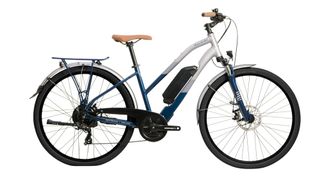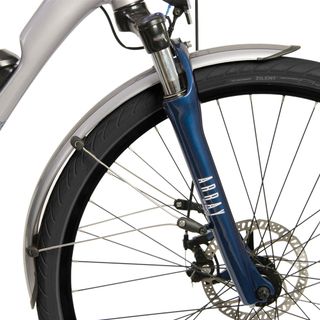You can trust Coach
E-bikes have been improving dramatically in the past few years and in 2021 there’s been a notable boom in urban bikes, the models designed to carry you and your shopping or work gear from A to B, rather than bikes tailored to the sports of road cycling or mountain biking. However, this type of bike hasn’t really become any more affordable – you can still expect to pay in the region of £2,000 (before you cash in the Cycle To Work discount at least).
Priced at £1,600, the Raleigh Array makes a move to undercut the competition, while still including essential accessories like mudguards, lights and pannier rack. It also cuts quite a dash with a two-tone blue and silver frame, as well as matching tan wheels, seat and grips. The looks are sullied a little by the large external battery, but external batteries tend to give a greater range than integrated ones, and the practical-minded will appreciate how easily it can be unlocked for charging away from the bike.

Compared with Raleigh’s next most affordable e-bike, the Motus (£1,900), the notable change is from a Bosch Active Line motor and range of 76 miles (122km) to the Array’s Suntour Canbus E25 motor and 60-mile (97km) range. The brakes on the Array are also mechanical rather than hydraulic disc brakes.
To my surprise, though, the Array weighs less than the Motus, at 23kg vs 24.5kg. That’s still a heavy bike, though, and it would be worth test-riding one – or an e-bike of a similar weight – if you don’t think of yourself as big or especially strong. As a six-foot tall man even I found it a little unwieldy when parking before and after a ride.
See related
It feels light to ride though, and the assistance is smooth and powerful in the highest of the four modes so there’s no problem getting away from the pack at traffic lights and up to speed. The seven gears gave a range that felt just right for me, giving me a slow enough cadence when cruising along around the limit of 25km/h. I needed the smaller chainrings as well, because the motor lacked a little oomph going up some of the steeper south London hills. Don’t worry that you’ll need to overexert yourself – you’ll still breeze past non-electric bike riders who are working up a sweat.
You’ll be overtaken on the flat though. A combination of the weight, chunky tyres and front suspension (which admittedly can be locked off) make this a bike for cruising in comfort at 25km/h, rather than going faster under your own steam. However, I was thankful for the beefy tyres and suspension when the bike dealt with a crater in the middle of the Trafalgar Square roundabout I’d missed while checking the traffic around me. The pothole was so deep I’m pretty sure I would have come off the usual hybrid I ride.

The handlebar display is tall and neat with an orange power button above the screen and up and down buttons underneath it which are in easy reach of your left thumb. The main number is your speed, with your level of assist, odometer and battery level also included but in smaller text. You can glance at your speed and take it in while riding, although the screen isn’t easily readable in bright sunlight. You’ll need to be stationary to check the other information, however.

While not every frame type (crossbar and open frame) is available in every size on the Raleigh website, if they do have your preferred option I can heartily recommend getting it shipped to you because Raleigh has nailed the set-up process. The instructions are clear, the bike comes with all the tools you need to put it together (including a smart-looking multi-tool), and the right and left pedals are clearly marked – plus advice on the direction to turn the bolt for each pedal is printed on the spanner.
As someone who has set up a number of bikes and had to figure out the final few steps to make them roadworthy in full view of the Cyclist magazine editorial team, I put a lot of value in bike manufacturers making that first experience easy and enjoyable, so kudos to Raleigh.
Beyond that quick start manual, however, instructions were scant and I could not for the life of me work out how to turn on the bike lights, nor could I find the answer on the internet. This eventually resulted in the ridiculous sight of me strapping bike lights to the handlebar and seat post. Eventually Raleigh’s representative confirmed that you have to hold the up button on the display for two seconds.
While the Raleigh Array isn’t the best e-bike I’ve tried, it’s the cheapest one that I have no qualms about recommending. Perhaps the thing I like most about it is that spending a few hundred pounds more won’t get you a dramatically better bike. If you’re not willing to spend more than £1,600, or just have a keen eye for a bargain, it’s a great option.
Buy from Raleigh | Find your local Raleigh stockist | £1,595

Jonathan Shannon has been the editor of the Coach website since 2016, developing a wide-ranging experience of health and fitness. Jonathan took up running while editing Coach and has run a sub-40min 10K and 1hr 28min half marathon. His next ambition is to complete a marathon. He’s an advocate of cycling to work and is Coach’s e-bike reviewer, and not just because he lives up a bit of a hill. He also reviews fitness trackers and other workout gear.

Coros Vertix 2S Review: The Garmin Fenix Rival Gets Some Useful Upgrades

I Tried CrossFit Champ Mat Fraser’s Signature 40-Minute EMOM And It Helped Me Build Strength, Skill And Endurance In One Fell Swoop

I Took A Test To Find Out If I Had What It Takes To Be An Elite Athlete And It’s Changed My Training For The Better
